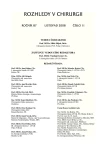-
Medical journals
- Career
Proximal Tibial Growth Plate Trauma in Childhood and Options for its Management
Authors: J. Škvařil; L. Plánka; J. Jochymek; P. Gál
Authors‘ workplace: Klinika dětské chirurgie, ortopedie a traumatologie FN Brno, přednosta: prof. MUDr. P. Gál, Ph. D., MBA
Published in: Rozhl. Chir., 2008, roč. 87, č. 11, s. 605-608.
Category: Monothematic special - Original
Overview
Aim:
Traumas to the proximal tibial epiphyseal growth plate account for less than 2% of all physeal injuries, therefore, it may cause diagnostic or therapeutic difficulties. The authors studied a group of patients treated in the Clinic of pediatric surgery, orthopedics and traumatology of the Brno Faculty Hospital (FN Brno) during past 11 years, in order to assess its treatment outcomes and complication rates.Methodology:
Based on the Salter-Harris (SH) classification, the studied patients with proximal tibia epiphyseolyses were assigned to groups using the following criteria: type of epiphyseolysis and treatment approach, and the authors identified associated complications in individual patients. The follow up assessment of the treatment course and results were performed for each of the groups. The studied parametres included: fixation duration, duration of subsequent rehabilitation care, knee joint mobility and complication rates (angulation, limb shortening, skeletal porosis and eventual reoperation).Results:
The studied complications were recorded in 2 subjects in the undislocated epiphyseolysis group treated conservatively, and a single complication was recorded in the traumatic fragment dislocation group. Out of the total of 19 patients, complications were recorded in 3 subjects (16%) and the remaining 16 patients (84%) had no complications or posttraumatic effects recorded.Conclusion:
The study results correspond to the literature data. Therefore, minimum complication rates and high treatment success rates using standard treatment procedures were demonstrated.Key words:
proximal tibial epiphysis – epiphyseolysis – complications – osteosynthesis
Sources
1. Rockwood, Ch. A., Wilkins, K. E., King, R. E. Fractures in children, volume 3, Philadelphia, J. B. Lippincott Company, 1984.
2. Benson, M. K. D., Fixsen, J. A., Macnicol, M. F., Parsch, K. Children’s orthopaedics and Fractures, second edition, London, Harcourt Publichers Limited, 2002.
3. Šnajdauf, J., Cvachovec, K., Trč, T. Dětská traumatologie, 1. vydání, Praha, Galén, 2002.
4. Dungl, P. Ortopedie. 1. vyd., Praha, Grada, 2005.
5. Plánka, L., Nečas A., Gál, P., Kecová, H., Křen, L., Krupa, P. Prevention of bone bridge formation using transplantation of the autogenous mesenchymal stem cells to physeal defects: an experimental study in rabbits. Acta Vet. Brno, 2007; 76 : 253–263.
6. Plánka, L., Chalupová, P., Škvařil, J., Poul, J., Gál, P. Schopnost remodelace distálního radia při hojení zlomenin v dětském věku. Rozhl. Chir., 2005; Oct 84(10): 505–510.
7. Burkhart, S. S., Peterson, H. A. Fractures of the proximal tibial epiphysis. J. Bone and Joint Surg., 1979; 61 : 996–1002.
8. Shelton, W. R., Canale, S. T. Fractures of tibia through the proximal tibiae epiphyseal cartilage. J. Bone and Joint Surg., 1979, 61 : 167–173.
Labels
Surgery Orthopaedics Trauma surgery
Article was published inPerspectives in Surgery

2008 Issue 11-
All articles in this issue
- Minimally Invasive Surgery in the Czech Republic
- The Dependence of Weight Loss on the Dimensions of Neoventriculus in Patients after Gastric Banding
- Biliary Ileus – Potential Complication of Cholecystolithiasis
- Initial Results of the Bipolar RFITT Coagulation in Advanced Stages of Hemorrhoidal Disorder Study
- Operation Treatment of the Humeral Shaft Fractures
- The Use of Biodegradable Materials in the Management of Bone Cysts in Children
- Hybrid Robot-Assisted Surgery, Aorto-Bifemoral Bypass with Reconstruction of Incisional Hernia
- Malone Antegrade Continence Enema Stoma in Children with Dysfunctions of Pelvic Organs
- Therapy of Lymphocele Following Kidney Transplantation
- Outcomes of Transperitoneal Laparoscopic Nephrectomy for Renal Adenocarcinoma
- Proximal Tibial Growth Plate Trauma in Childhood and Options for its Management
- Perspectives in Surgery
- Journal archive
- Current issue
- Online only
- About the journal
Most read in this issue- The Use of Biodegradable Materials in the Management of Bone Cysts in Children
- Biliary Ileus – Potential Complication of Cholecystolithiasis
- Operation Treatment of the Humeral Shaft Fractures
- Minimally Invasive Surgery in the Czech Republic
Login#ADS_BOTTOM_SCRIPTS#Forgotten passwordEnter the email address that you registered with. We will send you instructions on how to set a new password.
- Career

